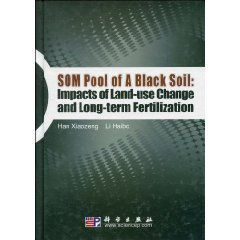內容簡介
 土地利用變化與施肥管理方式對黑土碳庫的影響
土地利用變化與施肥管理方式對黑土碳庫的影響圖書目錄
Foreword
1 Carbon cycling and SOM pool
1.1 Introduction
1.2 Global and terrestrial ecosystem carbon cycling
1.2.1 Introduction and history
1.2.2 Processes of carbon flow in the terrestrial realm
1.3 The composition of soil carbon pool
1.3.1 SOM fractions affected by land use
1.3.2 SOM pool as affected by long-term fertilization
1.4 Physical protection mechanism of SOM
1.4.1 Density separated fractions
1.4.2 Aggregate stability
1.5 Isotope technique protocd
1.5.1 SOM turnover
1.5.2 Carbon efflux
1.6 Summary
1.7 References
2 Description of the black soil zone in the northeast China
2.1 Ecological and environmental conditions of the black soil zone
2.1.1 Meteorological and hydrologic conditions
2.1.2 Parent material of black soil
2.1.3 Topography
2.1.4 Vegetation
2.1.5 Evolution and development of Mollisol
2.1.6 Land-use change and fertilization in black soil region
2.2 The common characteristics of black soil
2.2.1 The morphological characteristics
2.2.2 The physical properties
2.2.3 The seasonal dynamics of soil water
2.2.4 Clay minerals and chemical properties
2.3 Experimental sites——introduction to Hailun station
2.4 Experiment setup
2.4.1 Grass land and bareland
2.4.2 Long-term fertilization
2.4.3 Continuous and rotation cropping system
2.5 Summary
2.6 References
3 Experiment methodology
3.1 Study site description
3.2 SOM stocks estimation
3.2.1 Soil sampling
3.2.2 Analysis method
3.3 Density fractionation and extraction of humic substance
3.3.1 Soil sampling
3.3.2 Density fractionation
3.3.3 Chemical extraction of humus
3.3.4 Some soil properties
3.4 Wet sieving of aggregate
3.4.1 Study site description
3.4.2 Physical fractionation
3.4.3 Organic carbon determination of soil samples and isolated fractions
3.5 POM isolation from water-stable aggregate
3.6 SOM and aggregate stability of rhizosphere soils differing in continuous cropping patterns and vegetation cover
3.6.1 Soil and plant sampling
3.6.2 Aggregate wet-sieving
3.6.3 Organic carbon determination of soil samples and aggregate separates
3.7 Determination of C emission
3.7.1 Study site description
3.7.2 Experimental methods
3.8 Carbon budget
3.8.1 Sampling and determination
3.8.2 Carbon balance estimated through soil-crop-atmosphere systems
3.9 Statistical analysis
3.10 Summary
3.11 References
4 SOM stocks differing in land use and long-term fertilization
4.1 Introduction
4.2 Carbon distribution in soil profile
4.3 N distribution in soil profile
4.4 Soil bulk density in profile
4.5 C/N ratio in profile
4.6 SOM stocks
4.6.1 SOC densityand stocks
4.6.2 Nitrogen stocks
4.7 Conclusions
4.8 Summary
4.9 References
5 SOM in density fractions differing in land use and fertilization
5.1 Introduction
5.2 Soil properties analysis
5.3 Organic carbon and nitrogen contents in bulk soil
5.4 Carbon and nitrogen in density fractions
5.5 C/N ratio
5.6 Organic carbon in combined humus
5.7 The elemental composition and spectroscopic properties of humic substances extracted from a black soil
5.8 Conclusions
5.9 Summary
5.10 References
6 SOM distribution and aggregate stability differing in land use and long-term fertilization
6.1 Introduction
6.2 SOC and nitrogen at o-1o and lO-2O cm soil layer
6.3 Distribution of water-stable aggregates
6.4 C storage in water-stable aggregates
6.5 C distributed in density separated fractions from aggregates
6.6 Conclusions
6.7 Summary
6.8 References
7 SOM distribution and aggregate stability of rhizosphere soils differing in continuous cropping patterns and vegetation cover
7.1 Introduction
7.2 SOM and bulk density
7.3 Root density of crops and grasses
7.4 Mass distribution of water-stable aggregates
7.5 SOC in aggregates and correlation analysis
7.6 Conclusions
7.7 Summary
7.8 References
8 Aggregate stability and POM distribution: impacts of land-use change and long-term fertilization
8.1 Introduction
8.2 SOM in the whole soil and density fractions and related soil properties
8.3 Distribution of aggregates and SOM
8.4 POM content within the aggregates and in the whole soil
8.5 MOC content in aggregates and whole soil
8.6 C/N ratio of POM and MOC
8.7 Distribution of SOM fractions in the whole soil
8.8 Conclusions
8.9 Summary
8.10 References
9 CO2 emission characterization and carbon budget estimation through different ecosystems differing in land use and long-term fertilization
9.1 Introduction
9.2 Soil properties
9.3 Soil temperature and precipitation
9.4 Seasonal variations of CO2 emission
9.5 Related environmental factors to CO2 emission and Q,o estimation
9.6 Rhizosphere and native soil respiration
9.7 Cumulative CO2 emission and its relationship with SOC fractions
9.8 Plant biomass under different land use and fertilization
9.9 Carbon budget through soil-plant-atmosphere system
9.10 Carbon balance of soil ecosystem
9.11 Conclusions
9.12 Summary
9.13 References
